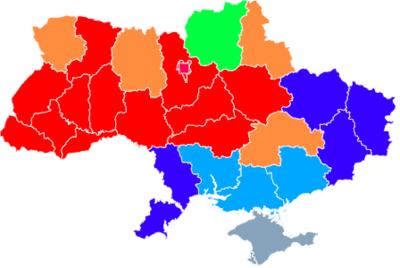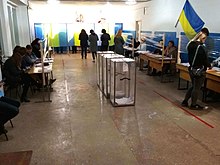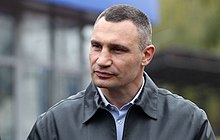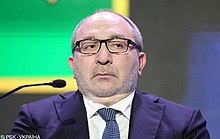2020 Ukrainian local elections
[5] On 15, 22 and 29 November and 6 December 2020 a second round of mayoral elections was held in cities with more than 75,000 voters where no candidate gained more than 50% of the votes.
[8] Of the remaining elected 733 mayors 30.74% of them were Servant of the People candidates, 12.43% represented For the Future, 7.24% Fatherland, 7.1% Opposition Platform — For Life, 6.15% Our Land and 5.6% European Solidarity.
[5] In Poltava, Kropyvnytskyi, Kryvyi Rih, Kherson and Zhytomyr voters received an additional fifth ballot for candidates for the district councils in the city.
[1][nb 1] Loss of government control of parts of the Donetsk Oblast and Luhansk Oblast (to the self-proclaimed Donetsk People's Republic and Luhansk People's Republic) also means elections were not held in certain parts of these provinces.
[22][23] Exit polls indicated that president Volodymyr Zelensky's party, Servant of the People, had suffered setbacks in Ukraine's major cities, including the capital Kyiv[nb 2]; it appeared that only in Zelensky's hometown[26] Kryvyi Rih Servant of the People won the election with a slight margin, although they lost the mayoral election there.
[28] According to calculations made by Sociological group "RATING" 49% of all voters voted for local parties/non-parliamentary parties.
[29] Of the remaining voters 14.5% voted for Servant of the People, 13.7% for European Solidarity and 12.5% for Opposition Platform — For Life.
[28] But in the elections of regional councils, parties represented in the Verkhovna Rada (Ukraine's parliament) still dominated.
[28] Servant of the People showed its best results in Central Ukraine in the north of the country, as well as in the historical regions Transcarpathia and Bukovina.
[28] Opposition Platform — For Life did well in South and Eastern Ukraine, although the local parties of city mayors (in particular in Odesa, Mykolaiv and Sloviansk) cost them support compared with its predecessor Opposition Bloc in the 2015 Ukrainian local elections.
[28] Proposition successfully performed only where it was represented by the current mayors of cities - in Dnipro, Zhytomyr and Mykolaiv.
[28] The same can be said for Svoboda, which won victory in cities where it had acting mayors, but compared with the 2015 local elections the party's electoral influence this time was limited to Western Ukraine.
[31] An exit-poll of sociological group "Rating" concluded that more than half of the voters who came to the polling station were over 50 years old.
[34] The voter turnout at the second round of mayoral elections held in Lutsk, Kramatorsk, Ukrainka, Odesa, Sumy, Kherson and Kamianets-Podilskyi on 15 November was on average 24%.
[39] At the time of his election his party assured that Kernes was about to return to Kharkiv to fulfil his duties as Mayor.
[41] In Odesa, incumbent Mayor Gennadiy Trukhanov (nominated by the Truth and Deeds(party) failed to be re-elected in the first round of the election.
[47] In the first round Trukhanov received 38% of the votes against Opposition Platform — For Life candidate Mykola Skoryk's 19%.
[47] (In the first round) Petro Obukhov of European Solidarity took third place with 11,5% of the votes and fourth spot was occupied by Oleh Filimonov [uk; ru] of Servant of the People with 10,09%.
[50] In the first round of the election Filatov (nominated by Proposition) had gained 46.41% of the votes, Krasnov (nominated by Community Power) 13.15%, Oleksandr Vilkul (Bloc Vilkul — Ukrainian perspective) 12.95%, Serhiy Nikitin (Opposition Platform — For Life) 9.15% and Serhiy Ryzhenko [uk] (Servant of the People) 8.71%.
[52] The NGO Committee of Voters of Ukraine stated that the second round of mayoral elections on 22 November were "held in accordance with democratic standards" but that in five cities of eleven voting cities its observer had uncovered attempts at bribing voters.





